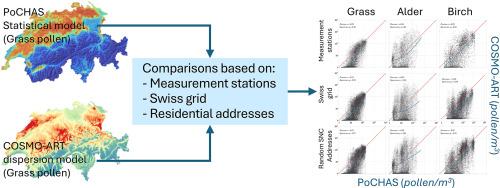Comparing alder, birch and grass pollen concentrations derived from spatiotemporal statistical and dispersion models across Switzerland
IF 3.7
2区 环境科学与生态学
Q2 ENVIRONMENTAL SCIENCES
引用次数: 0
Abstract
While several studies have compared the performance of statistical and dispersion modelling methods for air pollution, none have done so for pollen.
We developed a statistical machine learning model for daily pollen concentrations of five highly allergenic pollen types (hazel, alder, birch, ash, and grasses) across Switzerland (2000–2023). Daily average predictions for grass, alder and birch pollen were available for 2017–2023 from the COSMO-ART dispersion model, the operational forecast model at the Swiss Federal Office of Meteorology and Climatology. In this study, we have compared estimated concentrations for overlapping pollen types and years at three levels: (1) pollen measurement stations, (2) a 1 × 1 km national grid, and (3) residential addresses of the Swiss National Cohort.
At the grid and cohort address levels, statistical and dispersion models showed a strong correlation for grass (0.75) and birch (0.70) pollen and a moderate correlation for alder pollen (0.41). Cross-validated Pearson's correlations between statistically modelled and measured pollen concentrations ranged from 0.80 (alder), 0.85 (birch) to 0.86 (grass), with root-mean-squared logarithmic error (RMSLE) values of 0.33, 0.31 and 0.35, respectively. Pearson correlations between COSMO-ART predictions and measured concentrations were 0.41 (alder), 0.75 (birch) and 0.63 (grass), with the highest RMSLE of 0.88 for alder pollen, while RMSLEs of grass and birch models were 0.63 and 0.67, respectively.
Statistical models showed higher agreement with measured pollen concentrations at stations than COSMO-ART for all pollen types. Correlations between the two models were high for grass and birch pollen predictions, but notably lower for alder pollen.

比较桤木、桦树和草花粉浓度的时空统计和分散模型在瑞士
虽然有几项研究比较了空气污染的统计和扩散建模方法的性能,但没有一项研究对花粉进行了比较。我们开发了一个统计机器学习模型,用于分析瑞士(2000-2023年)五种高过敏性花粉类型(榛子、桤木、桦树、白蜡和禾草)的每日花粉浓度。从cosmoo - art弥散模型(瑞士联邦气象和气候学办公室的业务预测模型)可以获得2017-2023年草、桤木和桦树花粉的每日平均预测。在这项研究中,我们比较了三个水平上重叠花粉类型和年份的估计浓度:(1)花粉测量站,(2)1 × 1公里的国家电网,(3)瑞士国家队列的居住地址。在网格和队列地址水平上,统计和离散模型显示草花粉(0.75)和桦树花粉(0.70)具有很强的相关性,桤木花粉(0.41)具有中等相关性。统计模型与实测花粉浓度之间的交叉验证Pearson相关系数为0.80(桤木)、0.85(桦木)至0.86(禾草),均方根对数误差(RMSLE)分别为0.33、0.31和0.35。cosmoo - art预测值与实测值的Pearson相关性分别为0.41(桤木)、0.75(桦木)和0.63(禾草),其中桤木花粉的RMSLEs最高,为0.88,而禾草和桦木模型的RMSLEs分别为0.63和0.67。在所有花粉类型中,统计模型与站点花粉浓度的一致性高于cosmos - art。两个模型之间的相关性在草和桦树花粉预测中很高,但在桤木花粉预测中明显较低。
本文章由计算机程序翻译,如有差异,请以英文原文为准。
求助全文
约1分钟内获得全文
求助全文
来源期刊

Atmospheric Environment
环境科学-环境科学
CiteScore
9.40
自引率
8.00%
发文量
458
审稿时长
53 days
期刊介绍:
Atmospheric Environment has an open access mirror journal Atmospheric Environment: X, sharing the same aims and scope, editorial team, submission system and rigorous peer review.
Atmospheric Environment is the international journal for scientists in different disciplines related to atmospheric composition and its impacts. The journal publishes scientific articles with atmospheric relevance of emissions and depositions of gaseous and particulate compounds, chemical processes and physical effects in the atmosphere, as well as impacts of the changing atmospheric composition on human health, air quality, climate change, and ecosystems.
 求助内容:
求助内容: 应助结果提醒方式:
应助结果提醒方式:


